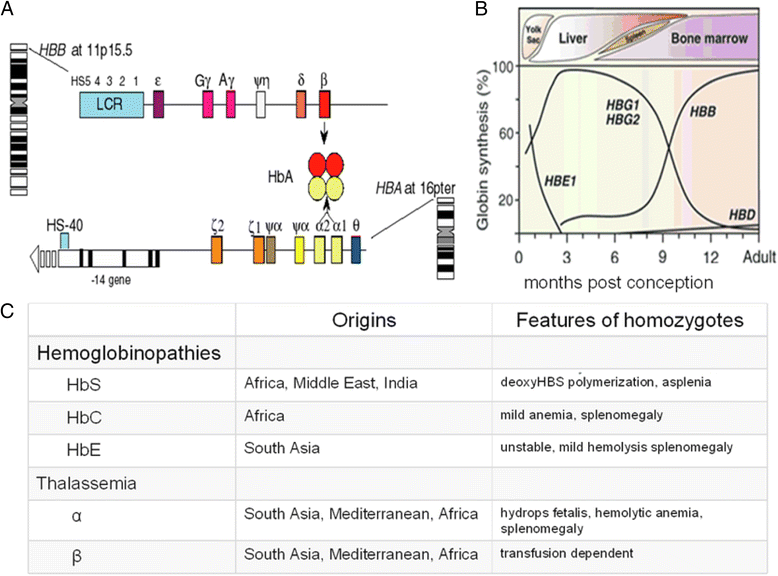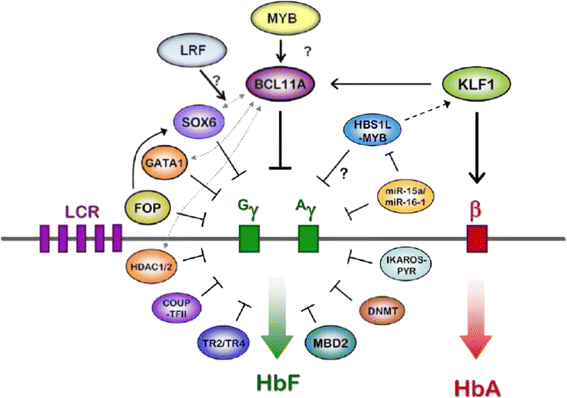Genomic approaches to identifying targets for treating β hemoglobinopathies
- PMID: 26215470
- PMCID: PMC4517356
- DOI: 10.1186/s12920-015-0120-2
Genomic approaches to identifying targets for treating β hemoglobinopathies
Abstract
Sickle cell disease and β thalassemia are common severe diseases with little effective pathophysiologically-based treatment. Their phenotypic heterogeneity prompted genomic approaches to identify modifiers that ultimately might be exploited therapeutically. Fetal hemoglobin (HbF) is the major modulator of the phenotype of the β hemoglobinopathies. HbF inhibits deoxyHbS polymerization and in β thalassemia compensates for the reduction of HbA. The major success of genomics has been a better understanding the genetic regulation of HbF by identifying the major quantitative trait loci for this trait. If the targets identified can lead to means of increasing HbF to therapeutic levels in sufficient numbers of sickle or β-thalassemia erythrocytes, the pathophysiology of these diseases would be reversed. The availability of new target loci, high-throughput drug screening, and recent advances in genome editing provide the opportunity for new approaches to therapeutically increasing HbF production.
Figures


Similar articles
-
Fetal hemoglobin regulation in β-thalassemia: heterogeneity, modifiers and therapeutic approaches.Expert Rev Hematol. 2016 Dec;9(12):1129-1137. doi: 10.1080/17474086.2016.1255142. Epub 2016 Nov 16. Expert Rev Hematol. 2016. PMID: 27801605 Review.
-
Targeting fetal hemoglobin expression to treat β hemoglobinopathies.Expert Opin Ther Targets. 2022 Apr;26(4):347-359. doi: 10.1080/14728222.2022.2066519. Epub 2022 Apr 26. Expert Opin Ther Targets. 2022. PMID: 35418266
-
BCL11A is a major HbF quantitative trait locus in three different populations with beta-hemoglobinopathies.Blood Cells Mol Dis. 2008 Nov-Dec;41(3):255-258. doi: 10.1016/j.bcmd.2008.06.007. Epub 2008 Aug 8. Blood Cells Mol Dis. 2008. PMID: 18691915 Free PMC article.
-
Epigenetic inactivation of ERF reactivates γ-globin expression in β-thalassemia.Am J Hum Genet. 2021 Apr 1;108(4):709-721. doi: 10.1016/j.ajhg.2021.03.005. Epub 2021 Mar 17. Am J Hum Genet. 2021. PMID: 33735615 Free PMC article.
-
Genetic Modifiers of Hemoglobin Expression from a Clinical Perspective in Hemoglobinopathy Patients with Beta Thalassemia and Sickle Cell Disease.Int J Mol Sci. 2024 Nov 5;25(22):11886. doi: 10.3390/ijms252211886. Int J Mol Sci. 2024. PMID: 39595957 Free PMC article. Review.
Cited by
-
From Stress to Sick(le) and Back Again-Oxidative/Antioxidant Mechanisms, Genetic Modulation, and Cerebrovascular Disease in Children with Sickle Cell Anemia.Antioxidants (Basel). 2023 Nov 7;12(11):1977. doi: 10.3390/antiox12111977. Antioxidants (Basel). 2023. PMID: 38001830 Free PMC article. Review.
-
Minireview: Prognostic factors and the response to hydroxurea treatment in sickle cell disease.Exp Biol Med (Maywood). 2016 Apr;241(7):730-6. doi: 10.1177/1535370216642048. Epub 2016 Mar 29. Exp Biol Med (Maywood). 2016. PMID: 27026724 Free PMC article. Review.
-
Study on Hydroxyurea Response in Hemoglobinopathies Patients Using Genetic Markers and Liquid Erythroid Cultures.Hematol Rep. 2016 Dec 9;8(4):6678. doi: 10.4081/hr.2016.6678. eCollection 2016 Nov 2. Hematol Rep. 2016. PMID: 28053695 Free PMC article.
-
Existence of HbF Enhancer Haplotypes at HBS1L-MYB Intergenic Region in Transfusion-Dependent Saudi β-Thalassemia Patients.Biomed Res Int. 2017;2017:1972429. doi: 10.1155/2017/1972429. Epub 2017 Feb 9. Biomed Res Int. 2017. PMID: 28280727 Free PMC article.
-
Scalable noninvasive amplicon-based precision sequencing (SNAPseq) for genetic diagnosis and screening of β-thalassemia and sickle cell disease using a next-generation sequencing platform.Front Mol Biosci. 2023 Dec 13;10:1244244. doi: 10.3389/fmolb.2023.1244244. eCollection 2023. Front Mol Biosci. 2023. PMID: 38152111 Free PMC article.
References
-
- Organization WH. Management of Haemoglobin Disorders, Report of Joint WHO/TIF Meeting. Nicosia: Cyprus; 2007.
Publication types
MeSH terms
Substances
Grants and funding
LinkOut - more resources
Full Text Sources
Other Literature Sources
Miscellaneous

